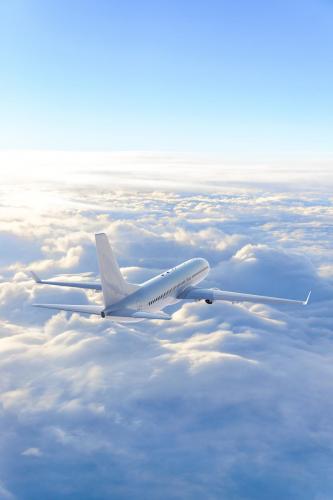Why Planes Are Among the Safest Modes of Transportation

In an era where speed and convenience are paramount, flight travel has become an indispensable part of our lives. Millions of people book flight ticket every day, jetting off to distant destinations for business, pleasure, or family reunions. But have you ever stopped to ponder why flights are considered one of the safest modes of transportation? In this blog, we'll explore the various factors that contribute to the safety of air travel, from rigorous maintenance standards to advanced technology and skilled professionals.
The Statistical Evidence
Before delving into the specifics, let's begin by looking at some cold, hard statistics. According to data from the National Safety Council, the odds of dying in a car accident in the United States are 1 in 107, while the odds of perishing in a plane crash are 1 in 9,821. These figures alone suggest that air travel is remarkably safe, especially when compared to other common forms of transportation.
So, what makes planes so safe? Let's break it down.
Stringent Regulations and Oversight
One of the primary reasons behind the safety of air travel is the strict regulations and oversight that govern the industry. Aviation authorities around the world, such as the Federal Aviation Administration (FAA) in the United States, the European Union Aviation Safety Agency (EASA), and the International Civil Aviation Organization (ICAO), establish and enforce rigorous standards for aircraft design, maintenance, and operation.
Aircraft manufacturers must adhere to stringent safety standards during the design and construction phases, ensuring that every plane is built to withstand a wide range of conditions and scenarios. These standards are regularly updated to incorporate the latest technological advancements and safety improvements.
Furthermore, airlines are required to perform regular maintenance checks on their aircraft, following comprehensive maintenance schedules to ensure that each plane is in optimal condition. These maintenance checks include everything from routine inspections to more extensive overhauls, all aimed at preventing potential issues before they become serious problems.
Advanced Technology
The aviation industry is at the forefront of technological innovation, constantly integrating cutting-edge systems and equipment into aircraft to enhance safety. Some of the key technological advancements contributing to aviation safety include:
a. Fly-by-wire Systems: Modern aircraft are equipped with advanced fly-by-wire systems that use computer-controlled electronic systems to manage flight control surfaces. These systems help stabilize the aircraft and prevent it from entering dangerous flight regimes, such as stalls or spins.
b. Collision Avoidance Systems: Aircraft are equipped with Traffic Collision Avoidance Systems (TCAS) and Ground Proximity Warning Systems (GPWS) that provide real-time data and alerts to pilots, helping them avoid potential collisions with other aircraft or obstacles on the ground.
c. Weather Radar: Advanced weather radar systems enable pilots to detect and navigate around adverse weather conditions, reducing the risk of turbulence-related incidents.
d. Enhanced Communication Systems: Improved communication systems allow pilots to stay in constant contact with air traffic controllers, receiving timely updates and instructions to ensure safe navigation.
e. Black Box Technology: Flight data recorders (commonly known as black boxes) capture critical flight data and cockpit conversations, aiding in accident investigations and helping identify potential safety improvements.
Highly Trained Professionals
Behind every safe flight are highly trained and skilled aviation professionals, including pilots, cabin crew, air traffic controllers, and maintenance personnel. These individuals undergo rigorous training programs and certifications to ensure they are well-prepared to handle various situations.
Pilots, in particular, are subjected to extensive training, including simulator sessions that simulate emergency scenarios, adverse weather conditions, and equipment failures. This training equips them with the knowledge and skills needed to respond effectively to unexpected challenges.
Air traffic controllers play a vital role in guiding aircraft safely through the skies, ensuring that they maintain a safe separation distance and follow prescribed flight paths. Their expertise and vigilance are crucial in preventing mid-air collisions.
Redundancy and Fail-Safe Systems
One of the fundamental principles of aviation safety is redundancy. Aircraft systems are designed with multiple backup mechanisms to ensure that critical functions can continue operating even if a primary system fails. This redundancy extends to engines, navigation systems, hydraulics, and more.
For instance, most commercial airliners have two or more engines, and they are designed to operate safely even if one engine fails. Similarly, the redundancy in the aircraft's electrical systems ensures that essential systems such as flight control and communication remain functional.
Moreover, fail-safe systems are built into aircraft to minimize the consequences of system failures. An example of this is the hydraulics system, which uses redundancies and backup components to ensure that control surfaces can be manipulated even if the primary hydraulic system fails.
Continuous Learning from Incidents
The aviation industry has a strong culture of learning from past incidents and accidents. When an incident occurs, aviation authorities and industry stakeholders conduct thorough investigations to determine the root causes and contributing factors. The findings are then used to implement safety enhancements and preventive measures.
As a result of this continuous learning process, aviation safety standards are continually evolving to address emerging threats and challenges. Lessons from past accidents have led to improved cockpit procedures, equipment design changes, and updated training programs for aviation professionals.
Conclusion
Air travel is undeniably one of the safest modes of transportation, and this safety record is the result of a multifaceted approach that encompasses stringent regulations, advanced technology, highly trained professionals, redundancy, and continuous learning from past incidents. While no form of transportation is entirely risk-free, the aviation industry's commitment to safety has made flying a remarkably safe and reliable way to traverse the globe. So the next time you board a plane, you can do so with confidence, knowing that you are in the capable hands of an industry dedicated to your safety above all else.
Post Your Ad Here
Comments